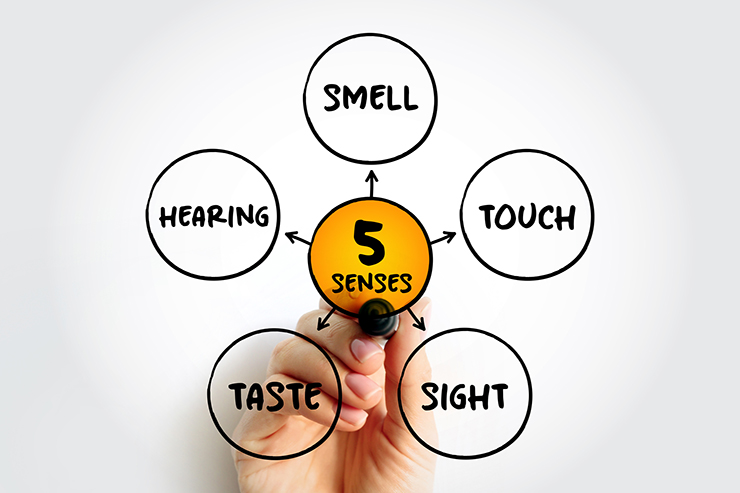If you ask an interior designer what makes a well-designed home, they will, in some form or fashion, allude to the five basic senses:
- Sight
- Smell
- Hearing
- Taste
- Touch
An appealing wall color with a pop of art, an aromatic air freshener, background music, homemade cookies on the counter, and interesting textures – these welcome guests into the space. Designers know that a space that appeals to the senses will draw people in and make them feel comfortable and connected.
Teachers know this as well. They expend a great deal of time and energy exploring ways to connect with their students using the five senses.
But when it comes to business, many leaders fail to engage the senses. If you have ever sat through a monotonous speech, a dry presentation, or a mundane meeting, you likely will agree that it was like visiting an uninviting house. You can’t wait to leave!
This is the opposite of connecting and engaging when it comes to communication.
Engaging the Senses Creates Impact
At this year’s International Maxwell Conference, Dr. John Delony did an amazing job of connecting with the audience. From the moment he walked onto the stage carrying a backpack until he unpacked it at the end, he had the audience’s attention. In the backpack were bricks representing burdens that people carry through life. The stories he told, and the “backpack of bricks” metaphor, engaged the senses.
Beyond delivering a speech that day, he created impact.
Think about the last speech or presentation you made.
Could you say the same?
Was the audience engaged?
Did they remember it well after you finished?
There is also the element of fun.
In our Maxwell DISC session, we talked about the different strengths and types of personalities. But we didn’t just talk about them. We showed video clips and engaged with the audience to tell us what type each person appeared to be. Some clips were inspiring, and some were funny; but they connected. Each person could see themselves in at least one scenario and, thus, they felt connected.
How can you create more engaging communications?
Prepare your presentations and meetings with the mind of a teacher or designer by asking: How can I appeal to the senses of my audience and team members?
Sight
What can you use to help your audience see what you are speaking about? Images, graphs, charts, infographics, video, object lessons, role play – these are just a few avenues you can use.
Smell
In a small setting, you may create engagement by serving coffee or refreshments. In a larger setting, you can accomplish this by more creative means such as telling a story so well that the audience can “smell the coffee”, so to speak.
Taste
The truth is, food is connective. In most cultures, eating together creates relationship bonding. Think about it. When you want to connect with someone, you will often say, “Let’s do lunch!” In a company, food can also be connective. If you’re speaking to an audience, of course, providing food is more of a challenge. But you can attend to water at each table and perhaps a piece of candy. And you can use stories, images, and metaphors of food to engage this sense.
Hearing
Does your conference need music at the beginning to get the audience up on their feet and excited to be there? Does your podcast introductory music set the tone for what is to come? Does your office meeting need the silencing of cell phones and interruptions to allow for full focus? Does your audience or your team have a voice, so they feel heard as well? This sense also focuses on the practical need to have clear audio communications, so you will want to invest the time and money to have quality, tested equipment when you speak.
Touch
Where there is a tactile experience, this enhances engagement and memory. For example, the act of writing down a goal increases the likelihood of reaching it. When you are communicating with your team or an audience, you can incorporate the sense of touch by having them take notes or fill in blanks. Even the act of holding a paper with the information will further underscore what you are saying. If you are conducting a workshop or meeting with remote audiences, you could also mail a package beforehand. The tangible package will help to forge a connection.
Engage the Senses
In your next meeting or speaking engagement, give this approach a try. You may be amazed at the impact it can make.
—
Action Steps
- Think about your next meeting or speaking engagement.
- Determine how you can bring in elements of each of the five senses.
- Observe the audience engagement.For valuable resources on Communication, click here.
Deb Ingino is a highly sought-after executive coach, mentor, consultant, and speaker worldwide. Deb is well versed in business operations and in the importance of asking key questions most business leaders won’t ask themselves. She brings deep experience in leadership development, strategy, high performance team building and effective communication. She has a passion for leading people to discover and maximize their strengths as well as those of fellow team members, while offering advanced strategies to achieve high performance. Deb is the perfect fit if you’re ready to take your leadership and impact to the next level!






+ view comments . . .